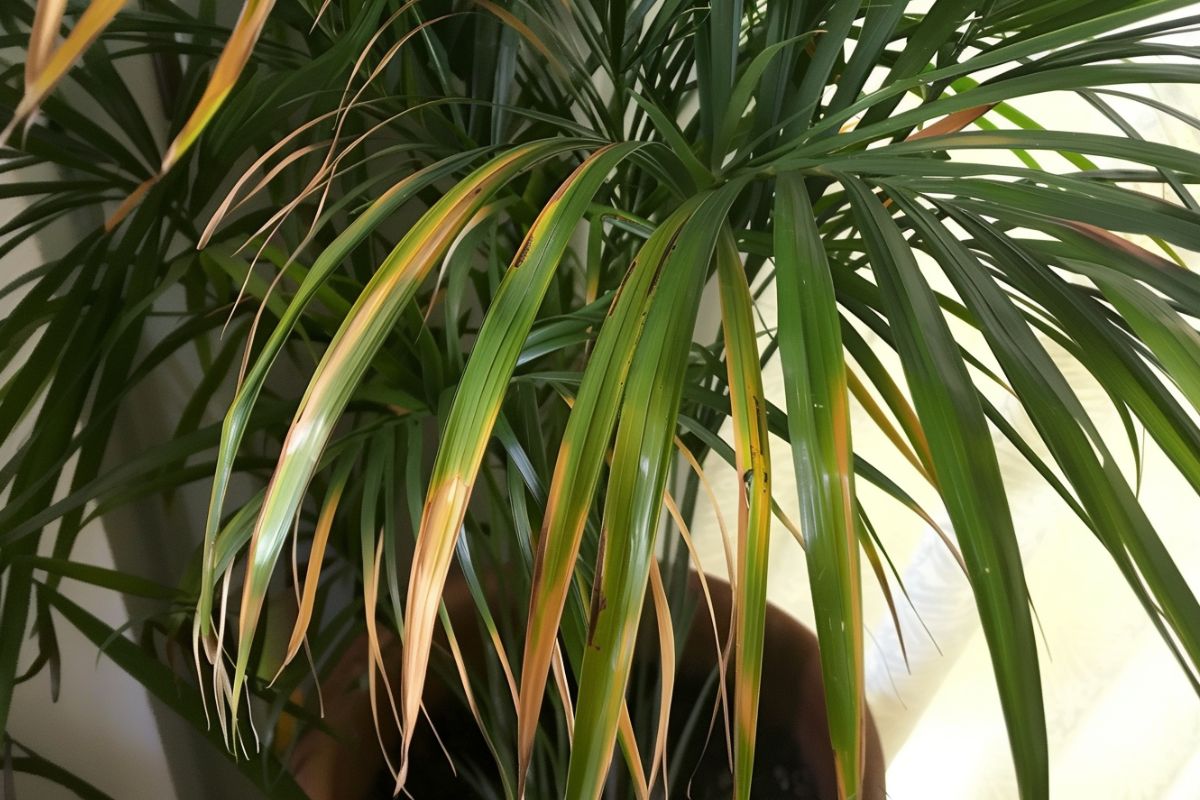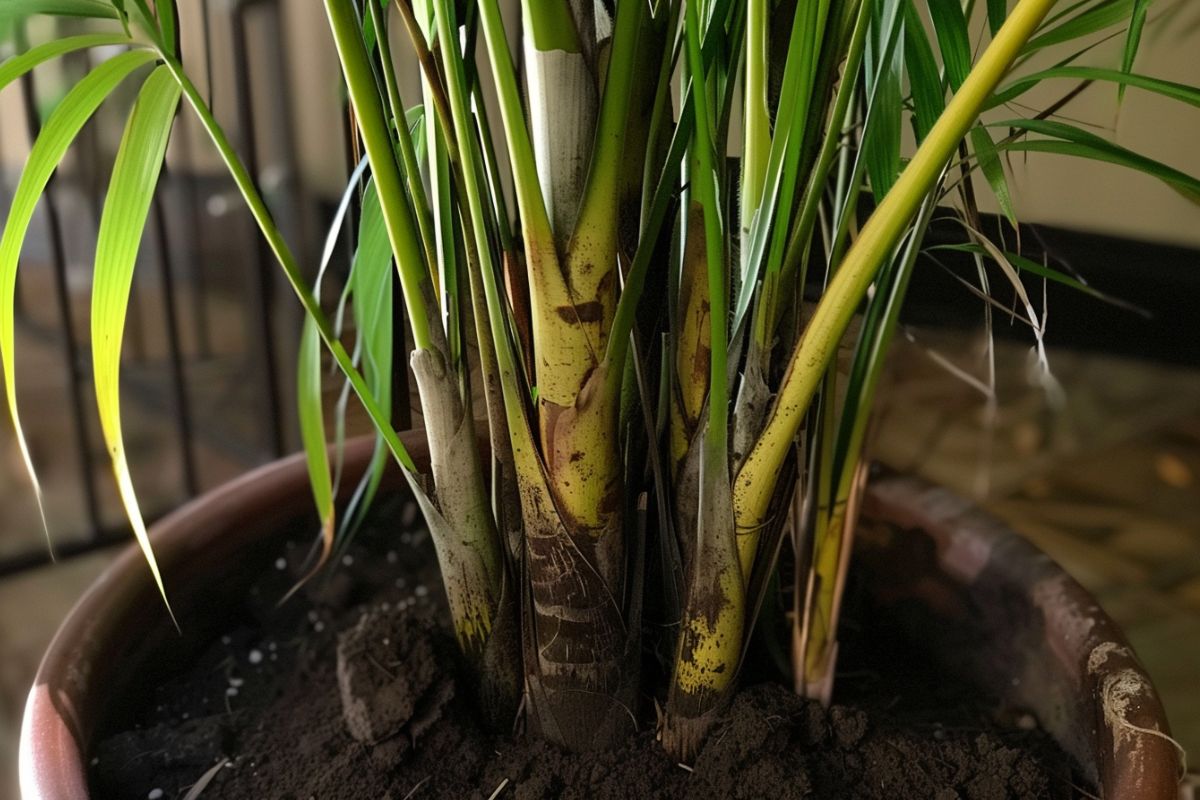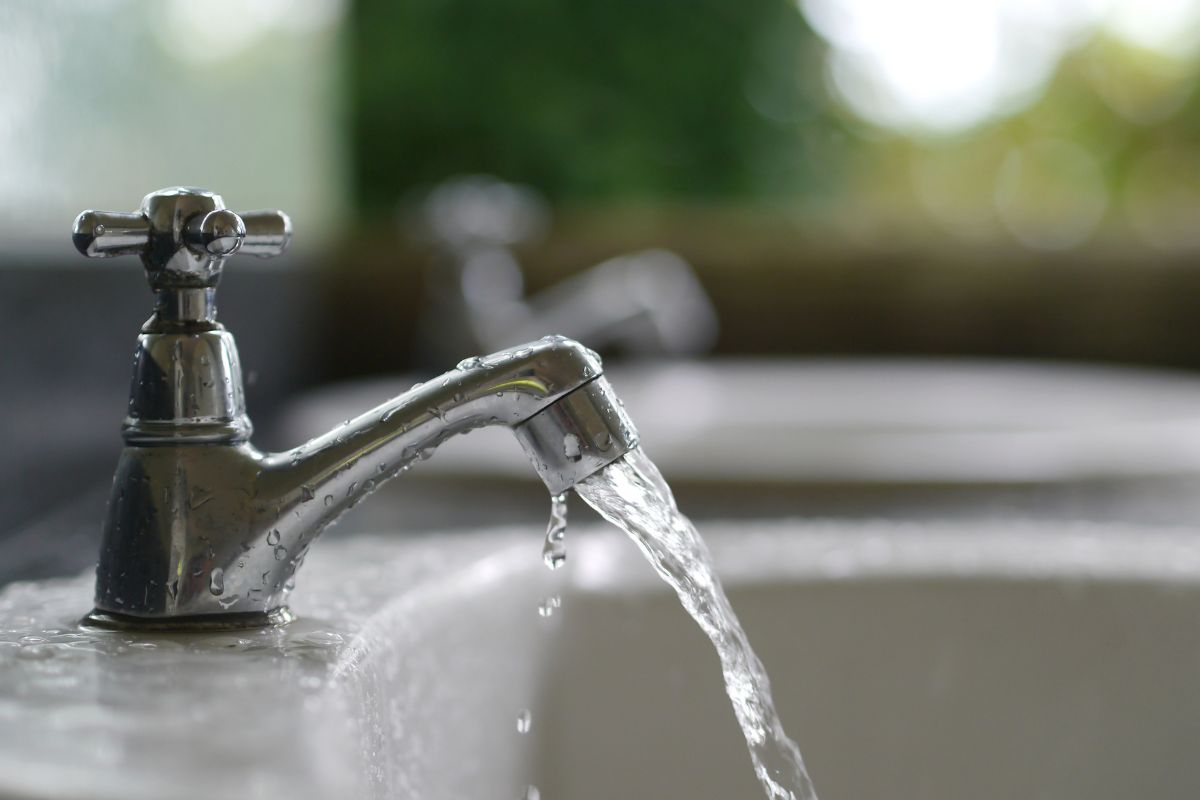Seeing your Areca palm droop can be worrying. You’re not the only one. Many of us wonder how to perk up our indoor plants. Let’s look into why Areca palms droop and how we can fix it.
This guide will cover common reasons for a droopy Areca palm, like too much or too little water and not enough light. You’ll learn how to identify and solve these issues, helping your palm stay lush and green.
Want to revive your Areca palm? Let’s go through some easy steps to keep your plant healthy. With a bit of care, your Areca palm can be vibrant and happy.
- Related article: How to Care for the Areca Palm
7 Key Takeaways on Areca Palm Drooping
- Areca palms require specific hydration, thriving in well-draining soil with regular watering and bright indirect light.
- Yellow or brown fronds and drooping are common signs of a sick or dying Areca palm.
- Plant in well-draining soil and water only when the top 1-2 inches are dry to avoid root rot.
- Regularly check for pests like mealy bugs and spider mites, which can cause droopy leaves and discoloration.
- Maintain 50%-70% humidity with humidifiers, pebble trays, and misting to prevent brown leaf tips.
- Use balanced, water-soluble fertilizers at half strength and apply every 4-6 weeks to avoid overfertilization.
- Provide adequate indirect light and rotate the plant to ensure even growth and prevent leaning.
Why Is Your Areca Palm Drooping?

If you notice your areca palms’ leaves drooping, don’t worry. This is a common issue, and there are several main reasons it happens. Usually, it’s because of watering problems. Sometimes, pests are the culprits. Let’s explore why your areca palms might be looking a bit sad and see how we can help them perk up.
1. Overwatered Areca Palm

Overwatering Areca palms leads to browning tips and leaves, which can harm the entire plant. To avoid this, use well-draining soil like a peat-based mix with perlite and a pot with drainage holes.
Water your Areca palm only when the top 1 to 2 inches of soil are dry, usually about once a week. A moisture meter is handy for checking. If overwatering happens, cut back on the watering frequency and let the soil dry out to help your plant bounce back.
2. Underwatered Areca Palm
Areca palms need just the right amount of water to stay healthy. If they don’t get enough, their leaves start to turn yellow and the tips turn brown. This happens because the plant can’t move nutrients around well. When the soil dries out, the Areca palm lets some leaves go to save moisture, which isn’t good for its health.
To keep your Areca palm happy, set up a regular watering schedule. The goal is to keep the soil damp all the time, but not soaked. Remember, things like how hot it is, the humidity, and how much light the plant gets can change how often you need to water it. In hot weather or dry places, it might need water more often.
Make it a habit to check the leaves and the soil. This way, you can spot any problems early and change how you water if you need to.
3. Areca Palms Watered With Chlorinated and Fluoridated Tap Water

Chlorinated and fluoridated tap water can harm Areca palms. These plants don’t like the chemicals in city water. Over time, these chemicals can build up in the soil and the plant takes them in, which is not good for them. If your Areca palm is sensitive to these chemicals, you might see:
- Brown Leaf Tips – This is often the first sign that fluoride is bothering the plant.
- Yellowing Leaves – Chlorine stops the plant from taking in nutrients, making the leaves turn yellow.
- Leaf Spotting – Chlorine and fluoride can cause spots and discoloration on the leaves.
- Drooping Leaves – The Areca palm can get weak leaves from the chlorine and fluorides in the water.
To keep your Areca palm safe from these chemicals, it’s best to use filtered or distilled water. You can also let tap water sit out overnight to get rid of some chlorine, but this won’t help with fluoride.
If you can, rainwater is perfect for them. It’s also good to water the plant a lot now and then to wash away any chemicals that have built up. You might think about getting a water filter to make the water better for your plants and yourself.
4. Areca Palms Receiving Insufficient Light

Areca palms enjoy light but not too much. They like bright, filtered light. If they don’t get enough light, their growth slows down, and their leaves droop. They can handle a bit of direct sunlight, but too much can burn their leaves, making the problem worse.
If you see your areca palm’s leaves turning pale green, it means it’s not getting enough light. These palms thrive in bright, indirect light. A good spot for areca palms is on a window sill where they can get plenty of light without the sun hitting them directly, especially during the hottest part of the day.
The best windows for areca palms are east and west-facing. These windows give the right amount of light. North-facing windows can make them too hot, and south-facing ones are okay if they only get morning sun.
5. Overfertilized Areca Palms
Overfertilizing Areca palms can cause health problems like brown leaf edges, nutrient imbalances, drooping leaves, and root damage. When you see brown tips on the leaves, it’s often due to too many salts in the soil from excess fertilizer. This situation can also lead to some nutrients being too high and others too low.
Moreover, too many nutrients can suffocate the roots, leading to root rot. Healthy roots need oxygen, and when they’re overloaded with nutrients, they can’t breathe. This condition shows up as yellowing leaves, especially near the base of the plant.
Here’s how to fix and prevent overfertilization in Areca palms:
- Water Correctly – Good watering helps stop salt from building up in the soil.
- Cut Back on Fertilizer – During the growing season, use a balanced, water-soluble fertilizer at half the strength suggested. Instead of fertilizing more often, do it every 4-6 weeks.
- Flush the Soil – If you think the plant is getting too much fertilizer, wash the soil with plenty of water to get rid of the extra salts. Make sure the water drains well to avoid soggy soil.
- Try Slow-Release Fertilizers – These give nutrients slowly over time, which helps stop overfertilization.
- Watch How the Plant Responds – Keep an eye out for stress or nutrient issues and change the fertilizer amount if needed.
6. Areca Palms Exposed to Low Humidity
Areca palms enjoy a humid atmosphere to stay in good shape. They do best when the humidity is between 50% and 70%. If the air gets too dry, especially indoors, you might see the tips of their leaves turning brown, drooping leaves, and overall poor health.
Here are some easy ways to make the air more humid for your Areca palm:
- Use a Humidifier – A humidifier in the same room as your Areca palm can significantly raise humidity levels.
- Create Pebble Trays – Place a tray filled with water and pebbles under the palm. As the water evaporates, it increases the humidity around the plant.
- Regular Misting – Lightly mist the leaves to boost humidity. Just be careful not to do it too much to prevent fungus.
- Grouping Plants – Keeping your Areca palm near other humidity-loving plants can create a small humid area.
- Monitor With a Hygrometer – A hygrometer helps you keep the humidity at the right level for your Areca palm.
These tips will help keep your Areca palm healthy, even if the humidity isn’t perfect. Using humidity trays or grouping plants can raise humidity levels. Misting isn’t very effective since the droplets evaporate quickly. To keep your Areca palms in top shape, consider getting some of the best plant humidifiers.
7. Pest-Infested Areca Palms
Spider mites are tiny pests that can hurt Areca palms. They can make the leaves droop too. To stop these issues, check your plants often and keep them clean.
These pests are small, making them hard to see. But you can spot them by looking for:
- Thin webs on the leaves and between the fronds.
- Tiny spots on the leaves.
- Bronze or yellow leaves
If you find spider mites, first, move the affected plant away from others. This stops the mites from spreading. Clean the leaves with soapy water or neem oil. This helps get rid of the mites and their webs.
A strong water spray can also knock the mites off. For a lot of mites, use insecticidal soap or horticultural oil to get rid of them all.
Other pests that might bother your Areca palms include:
- Scale Insects – Small and oval, they stick to leaves and stems. You can pick them off or use insecticidal soap.
- Mealybugs – They look like white, fluffy spots on your plant. Alcohol or insecticidal soap works well against them.
- Fungus Gnats – Tiny flies that show up if the soil is too wet. Let the soil dry out and use sticky traps.
- Aphids and Whiteflies – Small bugs or white spots on your plant. A strong water spray or organic insecticides will help.
To keep your Areca palms safe from pests, check them regularly. Make sure they have the right amount of water, humidity, and light. This keeps them strong and less likely to get pests.
Before adding new plants to your home, keep them away from others for a while. This stops pests from moving around. For eco-friendly pest control, use neem oil or insecticidal soap. If you have to use stronger chemicals, make sure to follow safety rules.
8. Potassium-Deficient Areca Palms
Areca palms often struggle with potassium deficiency, mainly because there’s not enough potassium in the soil. This problem gets worse with too much nitrogen compared to potassium, sandy soils losing nutrients easily, and imbalances in soil pH and chemicals.
When Areca palms lack potassium, their older leaves show it first. You might see the edges of these leaves turning brown and dry, a sign called marginal or tip necrosis. As the problem gets worse, the leaves can become frizzled and the palm’s canopy smaller. In bad cases, even new leaves can droop and turn yellow.
To fix and stop potassium deficiency, here’s what you can do:
- Check the soil to know its nutrient levels and pH.
- Use palm-specific slow-release fertilizers every three months, with the right N-P-K ratios like 3:1:3 or 2:1:3.
- Add well-rotted compost around the palms to boost soil health.
- Take care of any root diseases or planting problems that make it worse.
- Keep an eye on the palms and change your fertilization if needed.
By following these steps, you can keep your Areca palms healthy and looking great.
9. Areca Palms With Fungal Diseases
Areca Palms can droop due to fungal diseases, like bud rot and crown rot, mainly from fungi such as Phytophthora. These issues make the leaves yellow and droop. If not treated quickly, the plant can get very weak and may die.
| Disease/Issue | Prevention | Treatment |
|---|---|---|
| Leaf Spot Diseases | Space plants well for good air flow. Don’t water from above to keep leaves dry. Remove and destroy sick leaves. Use copper fungicides to prevent problems. | Use copper fungicides to stop problems before they start. |
| Pink Rot (Gliocladium blight) | Ensure good water drainage to avoid soggy soil. Maintain a steady watering routine. | For severe cases, use thiophanate-methyl fungicides. Remove sick plants quickly. |
| Bud Rot | Keep water off the palm’s crown. | Remove affected plants quickly to prevent spreading. Use fungicides on exposed plants. |
Areca Palm Problems Final Thoughts

Seeing drooping leaves on your areca palm can be worrying, but don’t lose hope. There are ways to bring your plant back to health. It’s important to know that drooping can happen for several reasons, but with the right care, your areca palm can thrive again.
The best approach is to prevent drooping and other issues before they start. This means keeping an eye on your plant and making sure it gets what it needs. If you notice the leaves starting to droop, act quickly. The longer you wait, the harder it may be to fix the problem.
Areca Palm Problems FAQs
1. How Do You Revive a Dying Areca Palm?
Revive a dying Areca palm by ensuring it gets proper care: plant this tropical plant in well-draining soil, keep the soil moist, provide bright indirect light, and fertilize monthly.
2. How Often Do You Water an Areca Palm?
Water Areca palms once a week during the growing season, ensuring they are neither too wet nor too dry to prevent root rot or wilting. Proper watering habits are crucial for this tropical plant to avoid yellowing leaves.
3. Why Is My Palm Plant Leaning?
This indoor plant leans towards light; support with a stake or rotate the pot 180° regularly to keep them straight. Regular adjustments prevent leaning and ensure even growth.
4. Should I Mist My Areca Palm?
Misting can help provide humidity and reduce dust on the leaves of this indoor plant, but in already humid areas, use a spray bottle filled with water instead. Proper humidity management prevents yellowing leaves.
5. How Do I Make My Areca Palm Bushy?
Make your Areca palm bushy by regularly pruning dead parts and trimming branches to encourage bushier growth. Regular pruning helps maintain healthy indoor tropical plants and prevents yellowing leaves.



